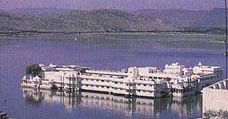 |
 |
|
|
Udaipur: Udaipur, India's lake city, is losing its charm as at least eight of its 12 major lakes have dried up due to severe heat. The once majestic lakes have become a grazing ground for livestock and a dumping ground for the city's garbage. Rajasthan's second most favoured tourist destination, Udaipur usually sees a heavy tourist inflow in May, which marks the beginning of the holiday season. But this year not only have the tourists not arrived, the few who are there are also thoroughly disappointed.
"It is called as the city of lakes and that is why we came here, to see the lakes, but there is immense water scarcity and lakes are all dry," said Monalisa, a tourist. "We are really sad. People here told us that for the last 2-3 years due to lack of rains all lakes have dried up. We were hoping that it will be a cool atmosphere but it is not. It's all very different from what we thought," added L Behar who has come all the way from Orissa. While Pichola, Swaroopsagar, Fatehsagar, Doodhtalai and Rani Sagar lakes are lying dry, even the garden complexes have lost their charm as there is simply not enough water to ensure their upkeep. All these lakes are artificial and were nurtured and maintained by the erstwhile kings of the region. Now it is looked after by municipal authorities. Scientists attribute the severe water shortage to lack of normal rainfall since the past few years. "Every year we have more than a hundred and fifty thousand tourists coming in but this year there has been an over 25 percent decline. There are many reasons for this but the biggest factor is the drying up of lakes," said the district tourist officer, Vikas Pandya. Rajasthan accounts for one-fourth of the total international tourist arrivals in India. Tourist arrivals in Rajasthan had fallen in the last two years due to India-Pakistan tensions and the September 2001 attacks in the United states. But government figures showed that foreign tourist arrivals in India in November 2002 have risen by 16.2 percent reversing a nine-month decline. The World Travel and Tourism Council expects India to be among three boom areas for tourism after 2003, even though it now accounts for barely 0.4 percent of the global tourism market, with just 2.4 million visitors in 2001. Analysts say Indian tourism suffers mainly from poor marketing, with the sector unable to exploit the potential of the country's snow-clad Himalayas, jungles, palaces and sun-soaked beaches. SARS in S-E Asia: Tourist boom in Darjeeling (Go To Top) Darjeeling: Shopping malls and restaurants in the picturesque Himalayan town of Darjeeling are teeming with visitors and hotel rooms have been booked for months in advance following a surge in the number of domestic and international tourists. Wary of visiting Sars-affected South-east Asian nations, visitors from far-flung Indian regions and abroad are falling to the old- world charm of this colonial hill station. Dinesh Sharma, general manager of Fortune Hotel, said Sars had proved to be a blessing in disguise since many people who would have otherwise gone to places like Singapore and Thailand were flocking to Darjeeling instead. He added: "Travellers from even Mumbai and Chennai sector are coming over to Darjeeling this year. We are sold out till the third week of June." Over the past few years, attractive pricing of tour packages lured hundreds of thousands of Indians to South East Asian countries. But the outbreak of Sars (severe acute respiratory syndrome) that has infected thousands of people globally and killed hundreds has created a scare in that region, prompting most of the visitors to stay away from the area. Abhinav Gupta, a tourist from Mumbai, said he cancelled his plans to visit South-east Asia because of the Sars-related uncertainty prevailing there. A return flight to Darjeeling from New Delhi costs nearly 400 dollars, while flying to Thailand is cheaper. Prohibitive flying costs and cumbersome rail journeys were hurting tourism in Darjeeling, but for the moment people are finding value-for-money in its snow-capped mountain peaks and the lively aroma of its famed tea. -ANI |
Previous Files
|
